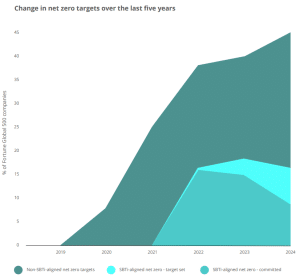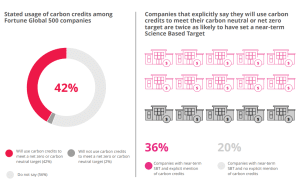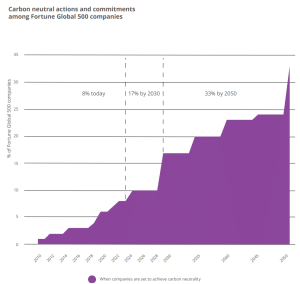Companies are key players in achieving global net zero goals by reducing emissions and adopting sustainable practices. With increasing pressure to lower their environmental impact, businesses are setting bold carbon reduction targets with the help of carbon credits, science-based targets, and innovative technologies.
Growth in Net Zero Targets
According to Climate Impact Partners annual report, net zero commitments among Fortune Global 500 companies have grown by 6%. This marks a resurgence after stagnation between 2022 and 2023, where only 2% of growth was recorded.
Currently, almost half of the Fortune 500 companies have set net zero goals, a significant leap from 2020, when only 8% of companies had such targets.
The Science Based Target Initiative’s (SBTi) Net Zero Standard has gained popularity among companies aiming to make credible net zero claims. However, its stringent requirements present challenges for many.
Notably, only 17% of Fortune Global 500 companies are using the SBTi framework, down from 18% the previous year. This dip suggests that while frameworks are available to guide companies, compliance with these standards can be difficult.
Last year, 15% of companies committed to setting SBTi-aligned net zero targets. Since then, 4% have had their targets approved, while 3% were removed. The rest are still in the process of getting their targets validated, which must be done within 24 months after committing.
About 35% of companies have established near-term Science-Based Targets (SBTs), a figure that has remained flat compared to the previous year. However, regional differences are evident.
In Europe, the percentage of companies with near-term targets decreased from 64% to 60%, while in North America, the figure rose from 38% to 43%. New SBT commitments from Fortune Global 500 companies in Europe and Asia have been recorded since 2024. Of them, 11 and 6 companies, respectively, commit to these targets.
Carbon Credits in Climate Action Plans
Carbon credits are playing an increasingly central role in climate action plans, per the report findings. Only 2% of companies have explicitly ruled out the use of carbon credits.
- Interestingly, companies that embrace carbon credits are 2x as likely to have near-term Science-Based Targets and 3x as likely to set net zero targets covering their entire value chain.
Contrary to criticism that carbon credits allow companies to delay internal emission reductions, research shows that companies purchasing credits are actually reducing their emissions faster.
Companies that have already achieved or plan to achieve carbon neutrality by 2030 are nearly twice as likely to have near-term Science-Based commitments.
Carbon Neutrality Progress and Regional Differences
The percentage of companies achieving carbon neutrality or planning to do so by 2030 has remained stable. Currently, 8% of companies are carbon neutral, while 9% aim for neutrality by 2030, and 17% by 2050.
In total, 34% of companies mention some form of carbon footprint compensation, with terms like “carbon neutral,” “climate neutral,” and “100% offset” frequently used.
There are notable regional differences in carbon neutrality targets as highlighted in the study. North American companies with targets set for 2050 increased from 30% to 32%. Conversely, European companies’ targets decreased from 59% to 51%.
Despite these targets, companies seem to be toning down their communication around carbon neutrality, with only 7% of companies mentioning their carbon-neutral achievements in their latest sustainability reports. This shift may be in response to rising regulatory scrutiny, particularly in the European Union, where carbon-neutral claims on consumer-facing products may be banned by 2026 as part of the Green Claims Directive.
Challenges in Reducing Scope 3 Emissions
Scope 3 emissions, which account for about 90% of most companies’ total emissions, remain one of the most challenging aspects of corporate climate action. These emissions are typically beyond a company’s direct control, making it difficult to meet value chain reduction targets.
New initiatives, such as the Voluntary Carbon Markets Integrity Initiative’s (VCMI) Scope 3 Flexibility Claim, have emerged to address these challenges. At the same time, the SBTi is considering revising its Scope 3 abatement rules. However, its recent update clarified that carbon credits cannot be used to meet the 90% Scope 3 reduction requirement.
The debate around Scope 3 emissions has also led to discussions about Beyond Value Chain Mitigation (BVCM), which encourages companies to purchase carbon credits for emissions beyond their immediate control.
The Future of Corporate Climate Action
As corporate climate action evolves, companies are balancing internal reductions with the use of carbon credits to meet both short- and long-term net zero targets. By purchasing carbon credits and taking responsibility for their emissions annually, companies can maintain clearer communication with stakeholders and foster internal buy-in for sustained climate efforts.
However, the increasing regulatory scrutiny, especially in Europe, could force companies to refine their climate messaging and strategies. These companies have to ensure that their actions align with credible frameworks to avoid greenwashing accusations.
The path to net zero remains complex, with regional, regulatory, and operational challenges. But by maintaining transparent and consistent climate action, companies can ensure long-term success in their carbon reduction and sustainability goals.





